|
 |
 |
|
Andaman and Nicobar
Islands
(unofficial coin issues) |
| |
|
Rajendra Chola I (1014 to 1042 CE), one of the Tamil Chola dynasty kings,
occupied the Andaman and Nicobar Islands to use them as a strategic naval
base to launch a naval expedition against the Sriwijaya Empire (a
Hindu-Malay empire based on the island of Sumatra, Indonesia). They called
the islands Timaittivu ("impure islands" in Tamil). The islands provided a
temporary maritime base for ships of the Marathas in the 17th century. The
legendary admiral Kanhoji Angre established naval supremacy with a base in
the islands and is credited with attaching those islands to India. The
history of organized European colonization on the islands began when the
Danish settlers of the Danish East India Company arrived in the Nicobar
Islands on 12 December 1755. On January 01, 1756, the Nicobar Islands were
made a Danish colony, first named New Denmark, and later (December 1756)
Frederick's Islands (Frederiksøerne). During 1754–1756 they were
administrated from Tranquebar (in continental Danish India). The islands
were repeatedly abandoned due to outbreaks of malaria between 14 April 1759
and 19 August 1768, from 1787 to 1807/05, 1814 to 1831, 1830 to 1834 and
gradually from 1848 for good. From 01 June 1778 to 1784, Austria mistakenly
assumed that Denmark had abandoned its claims to the Nicobar islands and
attempted to establish a colony on them, renaming them Theresia Islands. In
1789 the British set up a naval base and penal colony on Chatham Island next
to Great Andaman, where now lies the town of Port Blair. Two years later the
colony was moved to Port Cornwallis on Great Andaman, but it was abandoned
in 1796 due to disease. Denmark's presence in the territory ended formally
on 16 October 1868 when it sold the rights to the Nicobar Islands to
Britain, which made them part of British India in 1869. |
| In
1858 the British again established a colony at Port Blair, which proved to
be more permanent. The primary purpose was to set up a penal colony for
dissenters and independence fighters from the Indian subcontinent. The
colony came to include the infamous Cellular Jail. In 1872 the Andaman and
Nicobar islands were united under a single chief commissioner at Port Blair. Japanese occupation of the Andaman Islands. During
World War II, the islands were practically under Japanese control, only
nominally under the authority of the Arzi Hukumate Azad Hind of Netaji
Subhash Chandra Bose. Bose visited the islands during the war, and renamed
them as "Shaheed-dweep" (Martyr Island) and "Swaraj-dweep" (Self-rule
Island). General Loganathan, of the Indian National Army was made the
Governor of the Andaman and Nicobar Islands. On 22 February 1944 he along
with four INA officers - Major Mansoor Ali Alvi, Sub. Lt. Md. Iqbal, Lt.
Suba Singh and stenographer Srinivasan - arrived at Lambaline Airport in
Port Blair. On 21 March 1944 the Headquarters of the Civil Administration
was established near the Gurudwara at Aberdeen Bazaar. On 02 October 1944,
Col. Loganathan handed over the charge to Maj. Alvi and left Port Blair,
never to return. The islands were reoccupied by British and Indian troops of
the 116th Indian Infantry Brigade on 07 October 1945, to whom the remaining
Japanese garrison surrendered. At the independence of both India (1947) and
Burma (1948), the departing British announced their intention to resettle
all Anglo-Indians and Anglo-Burmese on the islands to form their own nation,
although this never materialized. It became part of the Indian union in 1950
and was declared a union territory on 1956. |
| |
|
Below coins are designed and produced by Joseph E. Lang. Native wildlife is
featured on this set of seven unofficial 2011 dated coins from the Andaman
and Nicobar Islands. In short, the territory is located in the Indian Ocean,
consists of 572 islands, of which just 38 are permanently inhabited.
Denmark, Austria and Britain all attempted to colonize the islands. Britain
eventually turned it into a penal colony. Japan occupied it in World War II.
They are now a Union Territory of India. Over the years the indigenous
inhabitants have been almost completely wiped out by disease, land
encroachments and punitive military expeditions. Most of the few hundred
that remain maintain a steadfast independence, refusing all outside contact.
The bi-metallic 20 Rupees pictures a Nautilus. The bi-metallic 10 Rupees
depicts a Dugong. An Indian Wild Boar is on the 5 Rupees. A Coconut Crab is
shown on the 2 Rupees. The 1 Rupee has a Kuhl’s Flying Gecko. A Stork-billed
Kingfisher is on the 50 Paisa and the Anadman clubtail butterfly is on the
25 Paise. The arms of the islands is on the obverse of each coin. Only
10,000 sets were minted. These were struck by Osborne Coinage in Cincinnati,
Ohio USA. JL initial is visible on the
reverse side of all these coins. |
| |
|
 |
25
paise. Year:
2011. Weight:
2.86g. Metal:
Copper.
Diameter:
19.00 mm. Edge:
Plain. Alignment:
Medal. Mint:
Osborne Coinage, USA. Obverse:
"ANDAMAN & NICOBAR ISLANDS" written at
the top. Emblem in the center with date at
the bottom. Reverse:
Anadman clubtail
butterfly with value
in four different languages.
Mintage:
10,000.
Minted Years: One year
type. |
|
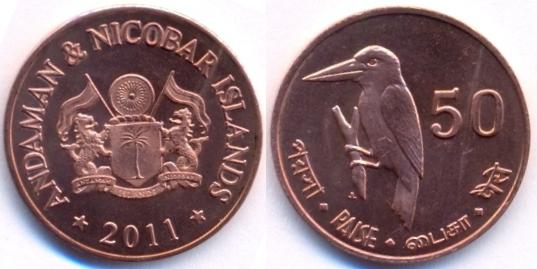 |
50
paise. Year:
2011. Weight:
3.95g. Metal:
Copper.
Diameter:
22.00 mm. Edge:
Plain. Alignment:
Medal. Mint:
Osborne Coinage, USA. Obverse:
"ANDAMAN & NICOBAR ISLANDS" written at
the top. Emblem in the center with date at
the bottom. Reverse:
Stork-billed
Kingfisher
with value in four different languages.
Mintage:
10,000.
Minted Years: One year
type.
Note: The four language sequence
on this coin is different than the rest of the coins. |
|
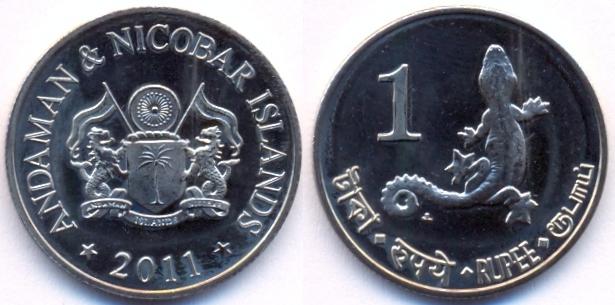 |
1 Rupee. Year:
2011. Weight:
5.42g. Metal:
Copper-Nickel.
Diameter:
25.00 mm. Edge:
Reeded. Alignment:
Medal. Mint:
Osborne Coinage, USA. Obverse:
"ANDAMAN & NICOBAR ISLANDS" written at
the top. Emblem in the center with date at
the bottom. Reverse:
Kuhl’s Flying
Gecko with value
in four different languages.
Mintage:
10,000.
Minted Years: One year
type. |
|
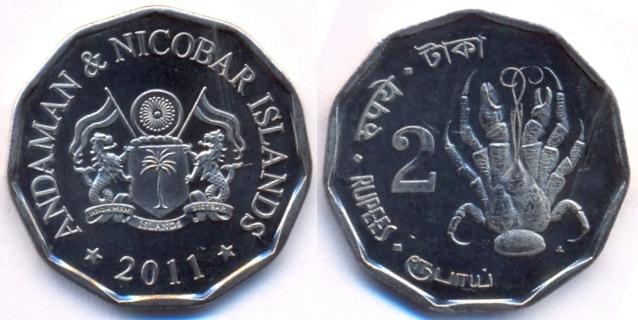 |
2
Rupees. Year:
2011. Weight:
6.04g. Metal:
Copper-Nickel.
Diameter:
11 sided; 26.00 mm. Edge:
Plain. Alignment:
Medal. Mint:
Osborne Coinage, USA. Obverse:
"ANDAMAN & NICOBAR ISLANDS" written at
the top. Emblem in the center with date at
the bottom. Reverse:
Coconut Crab
with value
in four different languages.
Mintage:
10,000.
Minted Years: One year
type. |
|
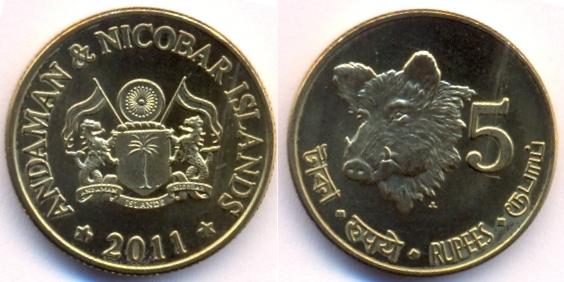 |
5
Rupees. Year:
2011. Weight:
7.03g. Metal:
Brass.
Diameter:
23.00 mm. Edge:
Reeded. Alignment:
Medal. Mint:
Osborne Coinage, USA. Obverse:
"ANDAMAN & NICOBAR ISLANDS" written at
the top. Emblem in the center with date at
the bottom. Reverse:
Indian Wild Boar
with value
in four different languages.
Mintage:
10,000.
Minted Years: One year
type. |
|
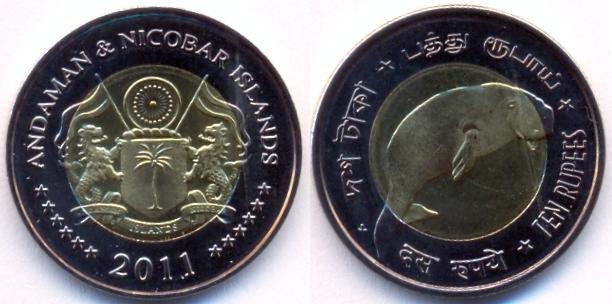 |
10 Rupees. Year:
2011. Weight:
5.78g. Metal:
Bi-metallic; Copper-Nickel as outer ring and
Brass in the center.
Diameter:
25.00 mm. Edge:
Reeded. Alignment:
Medal. Mint:
Osborne Coinage, USA. Obverse:
"ANDAMAN & NICOBAR ISLANDS" written at
the top. Emblem in the center with date at
the bottom. Reverse:
Dugong
with value in
four different languages.
Mintage:
10,000.
Minted Years: One year
type. |
|
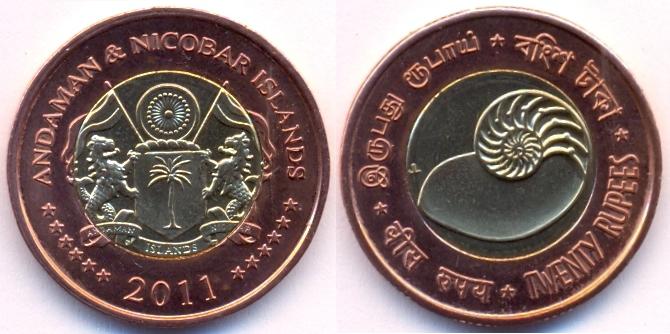 |
20
Rupees. Year:
2011. Weight:
8.59g. Metal:
Bi-metallic; Copper as outer ring and Brass in
the center.
Diameter:
27.00 mm. Edge:
Reeded and Plain; 12 patched each. Alignment:
Medal. Mint:
Osborne Coinage, USA. Obverse:
"ANDAMAN & NICOBAR ISLANDS" written at
the top. Emblem in the center with date at
the bottom. Reverse:
Nautilus
with value in
four different languages.
Mintage:
10,000.
Minted Years: One year
type. |
|
|
|
|
|
|
|
| |
|
|
| |
|
Micro-Nations |
| |
|
Chiefa Coins |
|
|








